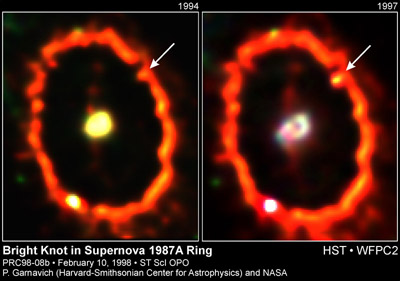This Hubble Space Telescope photograph shows supernova, 1987A, with its three rings. Material from the explosion has begun to hit the inner ring.
Click on image for full size
NASA and STScI
Exploding Stars
Stars don't last forever. Occasionally, a star bigger than our Sun will end its life in a huge explosion, called a supernova.
This explosion happens because the center, or core, of the star collapses in less than a second. The outer layers of the star are blown off in the explosion at speeds up to 9600 km/s (6000 miles/s), scattering heavy elements through space. Shock waves surge outward through space even faster, at up to 32,000 km/s (20,000 miles/s), and occasionally causing the initiation of new star formation regions. The contracting core that remains consists mainly of neutrons. There are many beautiful images of supernova remnants, the expanding shell of gas made up of the outer layers of the original star.
Supernovae last one or two years, and can shine brighter than a whole galaxy for this time. What happens to the star after the supernova depends on how big it is. If a star is only a few times bigger than the Sun, the core will shrink into a tiny neutron star only a few miles across. If the star was much bigger than the Sun, the core will shrink down to a black hole.
You might also be interested in:

An element (also called a "chemical element") is a substance made up entirely of atoms having the same atomic number; that is, all of the atoms have the same number of protons. Hydrogen, helium, oxygen,
...more
Scientists believe that the solar system was formed when the cloud of gas and dust was disturbed, perhaps by the explosion of a supernova. As with many explosions, such an explosion creates a shock wave.
...more
Everyone is awed by black holes. How could there be a thing that devours all light and matter around it...so that matter can never escape?!? Now, Dr. Tod Strohmayer, a scientist at NASA, has found that
...more
Scientists have found a possible source of the high speed atoms flying through space in the form of cosmic rays. These atoms reach velocities close to the speed of light. It was known that the source
...more
Shock waves from supernova explosion collide with gas ring!! Traveling at 40 million mph, a wave of energy released in a supernova explosion observed over a decade ago has begun to collide with a ring
...more
Scientists believe that the solar system was formed when a cloud of gas and dust in space was disturbed, maybe by the supernova of a nearby star. Shock waves from the explosion compressed the cloud of
...more
Williamina Paton Stevens Fleming was a Scottish-American astronomer who lived from 1857-1911. She discovered 10 of the 24 novae then known. Novae are stars whose brightness suddenly increases then slowly
...more















